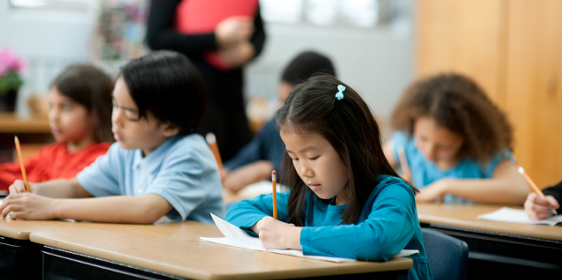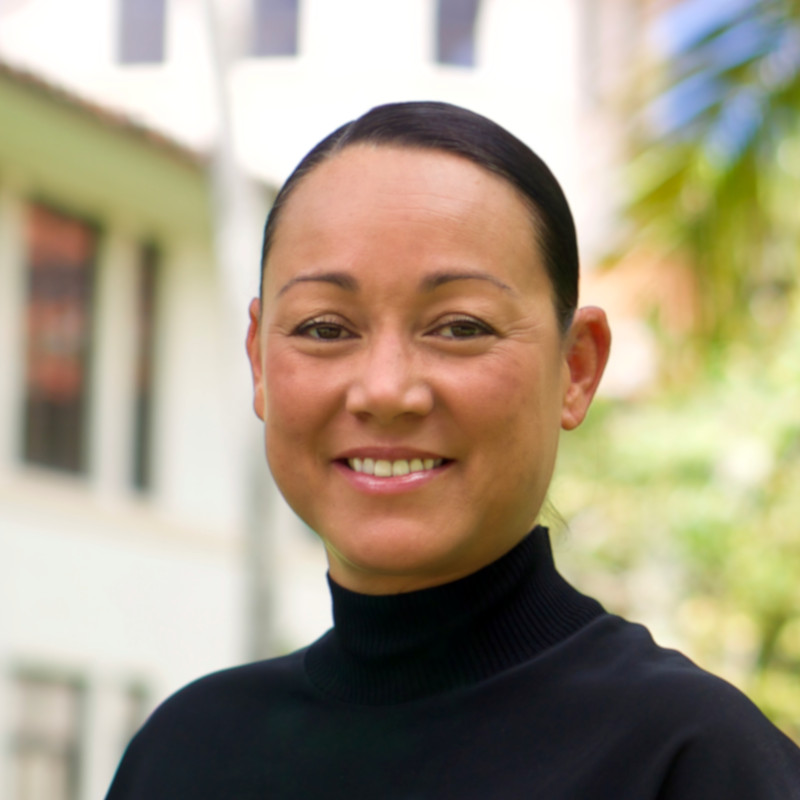
My two kids
By Paul McKimmy
In Fall 2013, two of my children started kindergarten at Noelani Elementary School — a well-regarded public elementary school in Honolulu. Both were eager to start school and love attending. Noah began at age 6, older than most kids in his class. Isabelle began at 4½, younger than most of the kids in hers.
This year, both children are midway through first grade at the same school. Isabelle is a voracious reader with a big vocabulary. She writes song lyrics for fun and reads books independently. She is highly verbal; enjoys her homework; and has logged more than 300 books in the first two quarters. Noah, however, has difficulty reading even the simplest books. He frequently has difficulty making himself understood when speaking. He is over a year older than Isabelle, but has clearly not progressed as far in reading, writing, or speaking abilities.
It seems clear enough that my kids aren’t being served equally. Their separate teachers have had equal time and opportunity to influence them, so why is Noah failed by our system while Isabelle thrives? Teaching proficiency, it seems, must be at the core of this disparity. The failure to effectively prepare Noah is a travesty. The school, its teachers, and the programs that prepared these teachers should be held accountable for these disparate results. The way to establish this accountability, is to measure our kids’ achievement and compare the schools, teachers and teacher preparation programs based on differences in their outcomes. We can thereby get rid of the poor-performing personnel, programs and institutions; investing our resources in better, more rigorous alternatives that serve our kids better.
This is exactly what the testing movement, our federal Department of Education and its corporate supporters would have us believe. And this is exactly how we are collectively “investing” in education. Test kids continuously, use the results to identify failures, and use these “failure” designations as rationale to invest in alternative programs like charter schools, voucher systems and privatized education — none of which play by the same rules as our under-resourced and over-regulated public schools.
But, there’s a major problem with this thinking — it entirely ignores the real story on the disparate results my kids, and others, are experiencing. Both of my kids’ teachers are excellent.
The school enjoys a strong reputation, an above-average facility, and high scores on school evaluations (See Noelani’s School Status and Improvement Report). So what’s the real story? Noah was my foster son. Isabelle is my birth daughter. Noah spent the first years of his life living in a car with his parents and his brother. His parents, unemployed and testing positive for drugs, had their car impounded and temporarily lost custody of their children. When Noah was taken into the foster system, his front teeth were pulled because they were rotten from lack of oral hygiene. He had never attended preschool, and he started kindergarten a year late because his parents never enrolled him. His brother tells me that they sometimes slept on the car’s hood to avoid bites from the bedbug and roach-infested car seats.
Isabelle, on the other hand, attended a “mommy’s group” and preschool from age 3. She has always had a home and a bed of her own. She has never had to worry about being hungry, where to sleep, or if she would receive medical attention. She has the benefit of after-school art class, ukulele lessons and a weekend soccer program.
Today, Noah lives with his parents again — in a park. They are homeless. They shower at a public facility and keep their belongings in a storage unit. They sleep outdoors on concrete. I see Noah regularly in the school cafeteria, and he visits on weekends to play with Isabelle. They’re both energetic, inquisitive, and happy kids.
But when I take Noah “home,” I know he’s going to be sleeping outdoors all night. After nearly two years of unemployment, his mother is finally working part-time in a fast-food restaurant. His father delivers papers. They tell me they’ve been on the list for public housing for two years.
Noah’s lack of progress in school is easy to pin on the “failure” of his teacher, his school and the education system — until you look at him as a person and not a test score. Every dollar we spend to increase his academic success by testing him, evaluating his school, and making a show of holding the public education system accountable is a joke. Noah doesn’t need a standardized test. He doesn’t need a more highly effective teacher, and he doesn’t need us to spend another billion dollars tracking his test scores with the goal of holding the teaching profession accountable for his success.
Noah needed preschool. Now he needs a bed with a roof over it. His parents need employment skills. His school may be the only public institution that has done right by him, and as far as I’m concerned his teachers are heroes. He needs you and me to prioritize our social service systems while investing in education. It is an absolute embarrassment, that instead, we continue defunding, attacking and blaming our public schools for his lack of success.
You may believe that Noah represents just one case, but he’s not alone. Just drive by our Kakaako medical college and witness the tent city nearby — there are many, many kids living on the edge right next to our luxury condos.
Nearly every study that examines the factors contributing to student success acknowledges that poverty has the greatest impact, and that teacher effectiveness is elsewhere down the list. So why do we continually gloss over this obvious point and rush to find new ways to try holding teachers and schools accountable for results? Because it’s easier than fixing the real problem, and because it suits political agendas to paint our education system as “broken” so that some group or company can sell us their program (quick-fix circumvention of quality teacher preparation), product (textbooks and software) or service (test preparation).
Our public school system is not broken, but it is suffering from our neglect. In fact, based on recent data from the National Center for Educational Statistics, “our public school system may be the best in the world.” That is, “except for the debilitating effects of poverty” (see Nation of Change, Jan. 12).
We don’t have a problem with a broken system or poorly performing teachers. We have a poverty vs. privilege problem; but we choose to attack public schools and the teaching profession as an easy target rather than addressing the real issues head-on.
Paul McKimmy is a faculty member in the University of Hawaii-Manoa College of Education. His children’s names were changed in this piece.
———
Editor’s note: The Star-Advertiser asked the Hawaii KIDS COUNT project for insight into poverty and education after receiving the “My Two Kids” essay on today’s cover. This commentary was written independent of that essay.
Fight poverty’s effects on children’s learning by strengthening the family
By Marianne Berry and Ivette Rodriguez Stern
In Hawaii, we greatly value the ohana and the well-being of all our children. Compared to other states, Hawaii ranks somewhere in the middle in overall child well-being, and we are doing well on some health indicators and in the family and community context. However, too many of our families are struggling and their children are not thriving.
About 13 percent of children under the age of 18 in Hawaii live in poverty (i.e., an annual household income in 2013 below $23,624 for a two-parent household with two children), and a third live in families that are low-income (annual income less than $47,248 for a family of four). The high cost of living in Hawaii amplifies the hardship of sustaining a family on these incomes.
Decades of research have documented the link between poverty and low academic achievement for children and youth. Compared with children from more affluent families, children growing up in poor families are more likely to have lower school attendance, and reading and math scores, and experience behavioral problems, grade failure and drop-out. These outcomes are especially likely for children whose families experience deep poverty, who live in poverty during early childhood, and who live in poverty for a long period of time.
The pathways by which poverty affects child development and educational outcomes are complex and often indirect. For example, children growing up in poor families are at risk for inadequate nutrition which in turns affects brain development and overall health. At the family level, parents experiencing ongoing economic hardship exhibit higher levels of stress, depression and increased risk of substance use, which may lead to less supportive parenting practices affecting children’s development and learning.
There are also community influences at play, including living in disadvantaged and high-risk neighborhoods with under-resourced schools and supports. The research documenting how poverty affects learning and educational outcomes is extensive, and these are but a few examples illustrating the various factors and relationships.
The effects of poverty build over time, with consequences at one stage impeding progress at a later stage. When the risks occur during early childhood, the consequences can be long-lasting. For example, school readiness in the early years is critical to later academic success, and most children who start kindergarten significantly behind their peers never quite close the readiness gap. Thus, these children tend to hold low-wage jobs or be under-employed as they transition into adulthood, many times perpetuating the cycle of poverty.
Childhood poverty clearly presents economic costs to all of us through an unprepared workforce and reduced productivity, and well as through increased crime and health expenditures. Reducing childhood poverty not only improves outcomes for children and their families, but also has implications for the state’s economy.
Until recently, this country’s approach to poverty focused separately on poor children and poor adults, rather than their interrelated needs. Increasing investments are being made in two-generation approaches that support both parents and their children in an effort to break the cycle of poverty.
Two-generation strategy recommendations therefore include strengthening policies that expand job-training, education and career opportunities for poor and low-income parents; adopting policies that give parents more flexibility at work, such as paid time off; increasing the Child Tax Credit for low-income parents; and expanding the Earned Income Tax Credit (EITC) to noncustodial parents as well as implementing a state EITC (demonstrated to increase family income and improve education outcomes for children).
Equally as critical is providing low-income families access to high quality and reliable child care and education. The research is clear that quality early care and education programs targeting poor and low-income families indeed minimize the achievement gaps caused by poverty.
———
Marianne Berry, Ph.D., is director of the Center on the Family at the University of Hawaii-Manoa; Ivette Rodriguez Stern, M.S.W., is junior specialist/Hawaii KIDS COUNT project director at the center. This piece first appeared in the Honolulu Star-Advertiser’s Insight section on Feb. 13, 2015.

